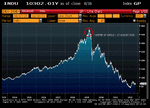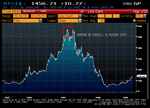MARKETS vs. ECONOMY: Morning comment - 23.08.2010
Good morning. You'd normally expect to see something like "Markets AND (not VS) Economy" in the header for a morning comment, however my wording is not a typo at all.
If you look at markets alone, things are looking up and the stocks are very attractive. Reasons for that are: 1) Loads of cash sitting on the sidelines waiting to be put into action, 2) as a result, a plethora of M&A deals where the bidder is willing to pay a hefty premium to the target's share price (if British Gas indeed gets snapped up at 16 quid, this will be the mother of such hefty premia), and, 3) most importantly, strong corporate earnings. Currently, 75% of the 484 companies in the S&P 500 that have reported have beaten Wall Street expectations, compared with a quarterly average of 62%, according to Thomson Reuters. I have rarely seen such a wicked bundle of mega positive bits for the markets.
BUT - there is a clear decoupling of markets from economy now. Some clever men are saying there is a 50/50 chance of economy dipping into recession and deflation from this juncture - I will argue we have not YET come out of the recession AND we ARE effectively in a deflationary environment already. I will leave deflation for tomorrow's comment - at the end of the day this is a morning comment for God's sake 🙂, not an article in FT - but I will comment here why we are still DEEPLY in the recession. Answer in fact is very short - job growth, or the lack of it.
In the attachment you will find a little-known (and too bad it is that little-known!) civilian employment-population ratio - in contrast to the better-known unemployment rate, which measures the percentage of working-age Americans who are actively seeking jobs but do not have one, the civilian employment-population ratio measures the percentage of working-age Americans who have a job, whether they are seeking one or not. This distinction matters because the state of an economy affects whether someone looks for a job at all. Bad times discourage potential workers from seeking jobs; boom times encourage marginal workers to seek them. Looking at this ratio, America is suffering its largest drop since World War II. In 2007, a little over 63% of adult Americans had jobs. Recent report shows that only about 58.4% do, a decline of nearly five percentage points. While the unemployment rate remains steady at 9.5%, the employment-population ratio continues to fall each month. In April it was 58.8%, in May 58.7%, and in June 58.5%.
Since America has about 238 million civilian adults of working age, this decrease means that we have nearly 12 million (!!!) fewer jobs today than if the employment-population rate were still at its 2007 level of 63%. No other recession in the past 60 years saw such rapid job destruction in either absolute or percentage terms. In the 1979-82 recession, unemployment topped out at a higher rate, 10.8%, but the employment-population ratio declined by only three percentage points, to 57% from 60%.
And those clever men are saying there is a 50/50 chance of a double-dip recession? We are actually - in many ways - still at the bottom of the recession! Worst thing is that today's leaders will NOT do what was available to Reagan and Maggie in 1982 - I am talking Reagan's tax cuts in 1983 and 1986 tax reform that lowered the top marginal income tax rate to 28%, allowing America to employ the millions of late baby boomers, women and immigrants who sought jobs. That led to the employment-population ratio recovering in less than two years after hitting bottom - the sort of momentum that continued for the rest of the decade (see chart attached).
The result is obvious - companies are more inclined to put loads of money that they have into mergers and acquisitions to grow, with the net result being more job loss than creation. Is there light at the end of the tunnel? Yes, and perhaps an unusual one - health-care reform. Companies are also slow to hire because they are still unclear on how much health-care reform is going to cost per employee. If that is cleared up favourably - it will be a massive burden off hiring shoulder!
And now back to why I am bullish in this grim environment. Health-care reform may help loads, but at the end of the day, it is strong corporate earnings that'll fix the hiring (and spending). And that is the bit we have firmly in place. The only reason why (with this gloomy reality in jobs market) we are not sitting at the bottoms of March 2009 is that the markets tend to run ahead of the economy. And - with this sort of corporate earnings - they have much more way to run!
THINGS TO WATCH THIS WEEK: Last Thursday saw a surprise jump in initial jobless claims to 500,000, with those numbers subject to revision this coming Thursday. Coupled with an anticipated downward revision to the second-quarter GDP, many are wondering if the 500,000 figure was an anomaly or something more troubling. On the earnings front, I want to see how the ex-darling of NASDAQ, JDS Uniphase reports on Wednesday and how Tiffany sees its high-income-bracket customer base spending on Friday.
RUSSIA:
- Blackout in St Petersburg. NEGATIVE for FEES. Electricity supply of several areas of St. Petersburg was disrupted on Friday at about 18:40 Moscow time due to the accident, according to preliminary data, occurred at one of the power substations of Federal Grid Company (FEES). There was no electricity in most parts of the city and region during a few hours. After emergency protection system worked out four TGC-1's (TGKA) thermal power plants were stopped. We believe that before the announcement of official reason it is premature to make any conclusions. However, this fact once again confirms the need to increase investments into power sector. We believe that in short term news may be negative for FGC's (FEES) performance, while in the long term we may expect from the government further steps aimed at improving the situation in the industry, as well as possible staff reshuffles;
- 2009 FRP tenders raise government's concern. NEGATIVE. The FAS will be on the watch. Experts, who supervise pharmaceutical industry, investigated the government FRP tenders held in 2009 and now suspect that the Ministry for Health and Social Development acted in price collusion with the largest pharmacy producers and distributors (among which there are apparently Pharmstandard and Protek). The investigation found that unfair terms set during the tenders led to artificially smaller number of participants and high prices that implies inefficiency of such pricing mechanism in terms of budget savings. We now expect FAS inspectors to implement further investigation. This may be negative for those pharma companies, which may be exposed as unfair participants. We remind that FRP budget in 2009 totaled RUR80 bn (about $2.5 bn) or 16% of the total Russian pharma market. In particular, Pharmstandard sales of anticancer drug Velcade (the company acted as distributor) under the government tender in 2009 totaled $115 mn or about 15% of the company's total sales. We expect more details to follow;
- UTair (TMAT) shows positive operating data in July 2010. POSITIVE.
- Rosneft (ROSN) to develop a gas field in UAE. NEUTRAL. Investing in the UAE gas field Sharjah. Rosneft and Crescent Petroleum (United Arabic Emirates) will invest $630 mn in exploration of a UAE gas field Sharjah. In May this year, Rosneft acquired 49% in this project for an undisclosed amount. The plot's gas reserves are currently estimated at 70 bcm of natural gas and 16 mn tn of condensate. If the exploration is successful, production may be launched in 2013. The gas will be sold domestically and exported. Crescent Petroleum currently has projects in United Arab Emirates, Oman, Yemen, Egypt and Pakistan; and also previously in Canada, Yugoslavia, France, Tunisia and Argentina. Unlike Lukoil, Rosneft has limited exposure overseas (currently, only exploration projects in Kazakhstan and Algeria). Further international expansion and partnership with players from different geographic regions would benefit the company, in our view.
TRADING ACTIVITY:
On Friday we had extremely low trading activity, though most of our flows remained unchanged except for blue chips where tend to have high frequency trades for our arbitrage clients. In utilities we kept on buying TGKs - 6,7,9,11, had a seller in TGK5; some demand came back into distribution sector with bids around MRKHP, MRKK; at the moment we have a 2-way market in size in OGK1; buyer in IRGZ; in metals sector we continue to be sellers of VSMZ, UNKL; have some sellers in infrastructure names.
Good week ahead to you!



